Business Casual Men’s Attire & Dress Code Explained
When you buy something using the affiliate links on our site, we may earn a small commission.

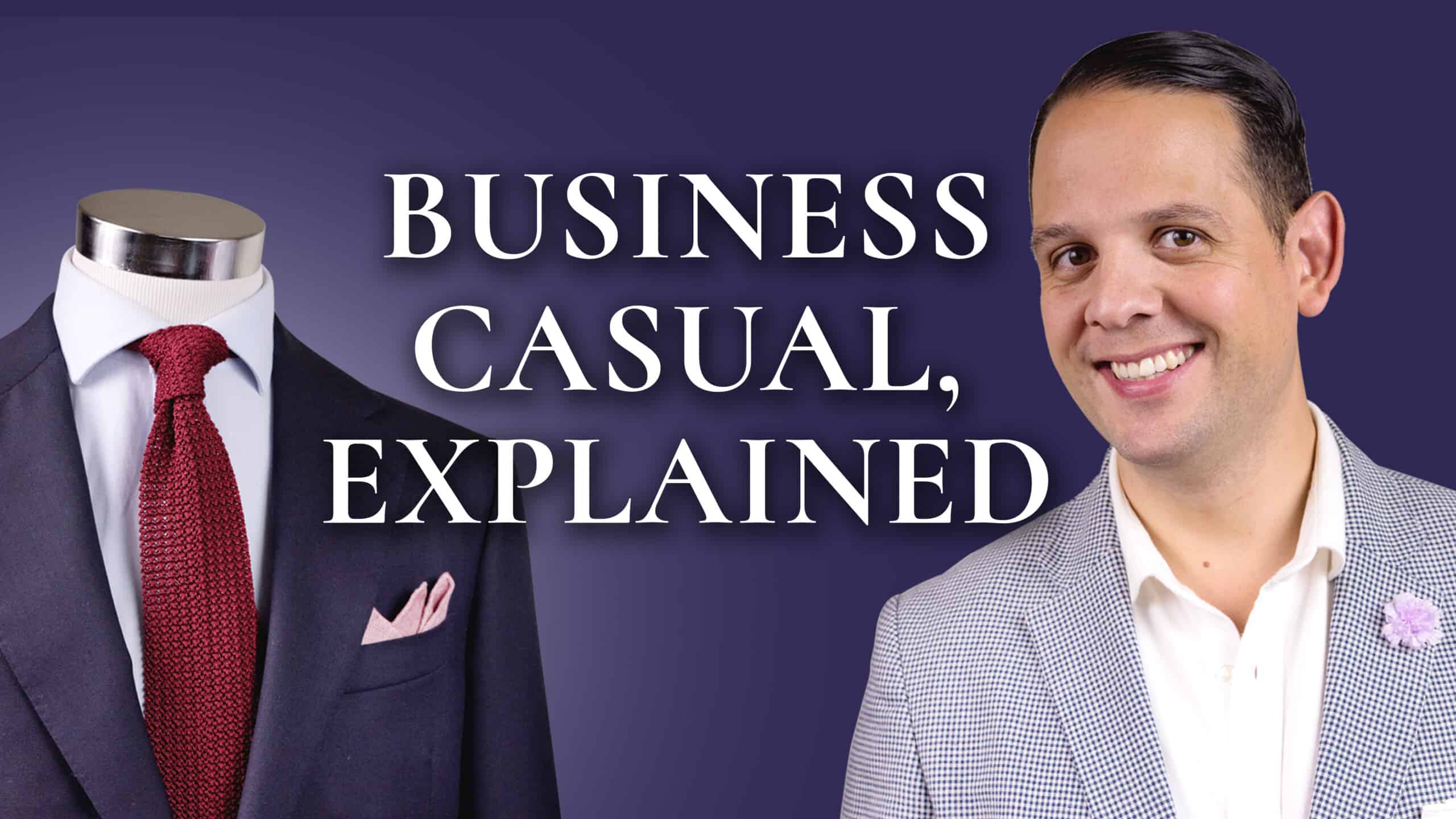
It’s hard to ignore that in today’s world, casual clothing reigns supreme. So what does that mean when you go to work? Are shorts good to go? Is a suit too stuffy? In this guide, we look at the perfect middle when it comes to office attire: the business casual dress code.
Mục Lục
Learn the Basics in Our Video Guide
Raphael takes you through some more business casual pointers in the below video. Don’t forget you can also find our guides to building a business casual capsule wardrobe, a guide all about business casual shoes, and a comprehensive look at business casual’s sibling, the smart casual dress code.
History of Business Casual For Men
Until recent years, the Business Casual attire dress code did not exist. There was simply daywear and evening wear. During the day, men would wear a stroller coat or a morning coat for business. In the evening they would change into a tailcoat for dinner and events. The most casual attire a gentleman might wear would have perhaps been a tweed suit while shooting or for a walk in the park.
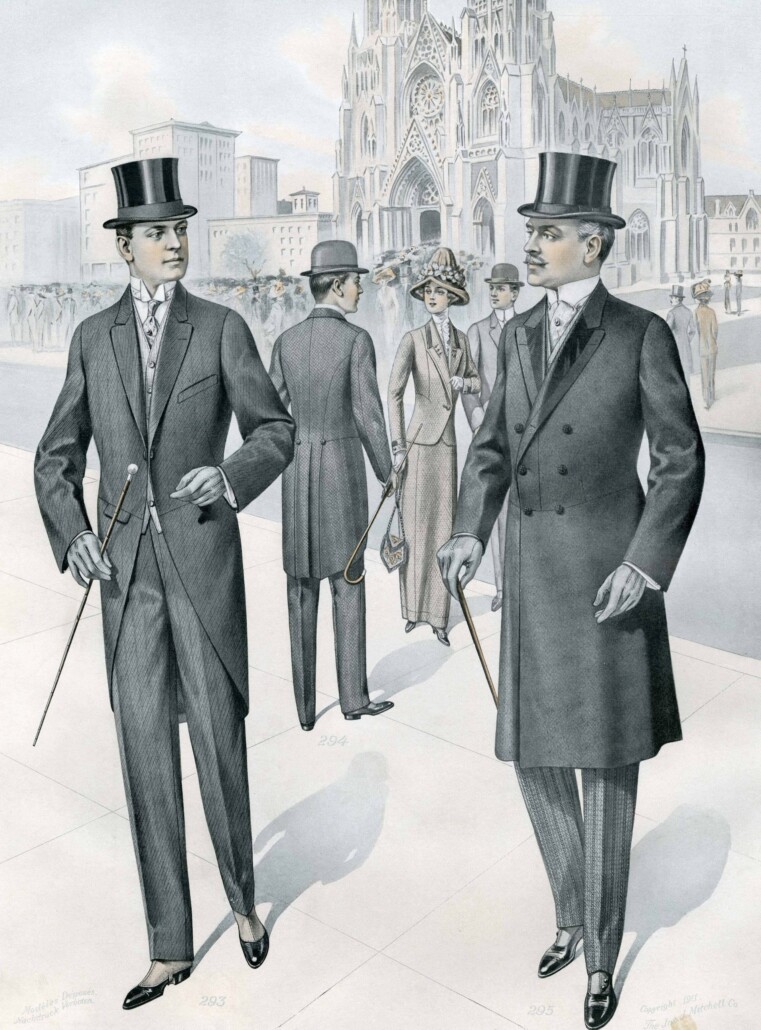 A group of businessmen at the turn of the 20th Century
A group of businessmen at the turn of the 20th Century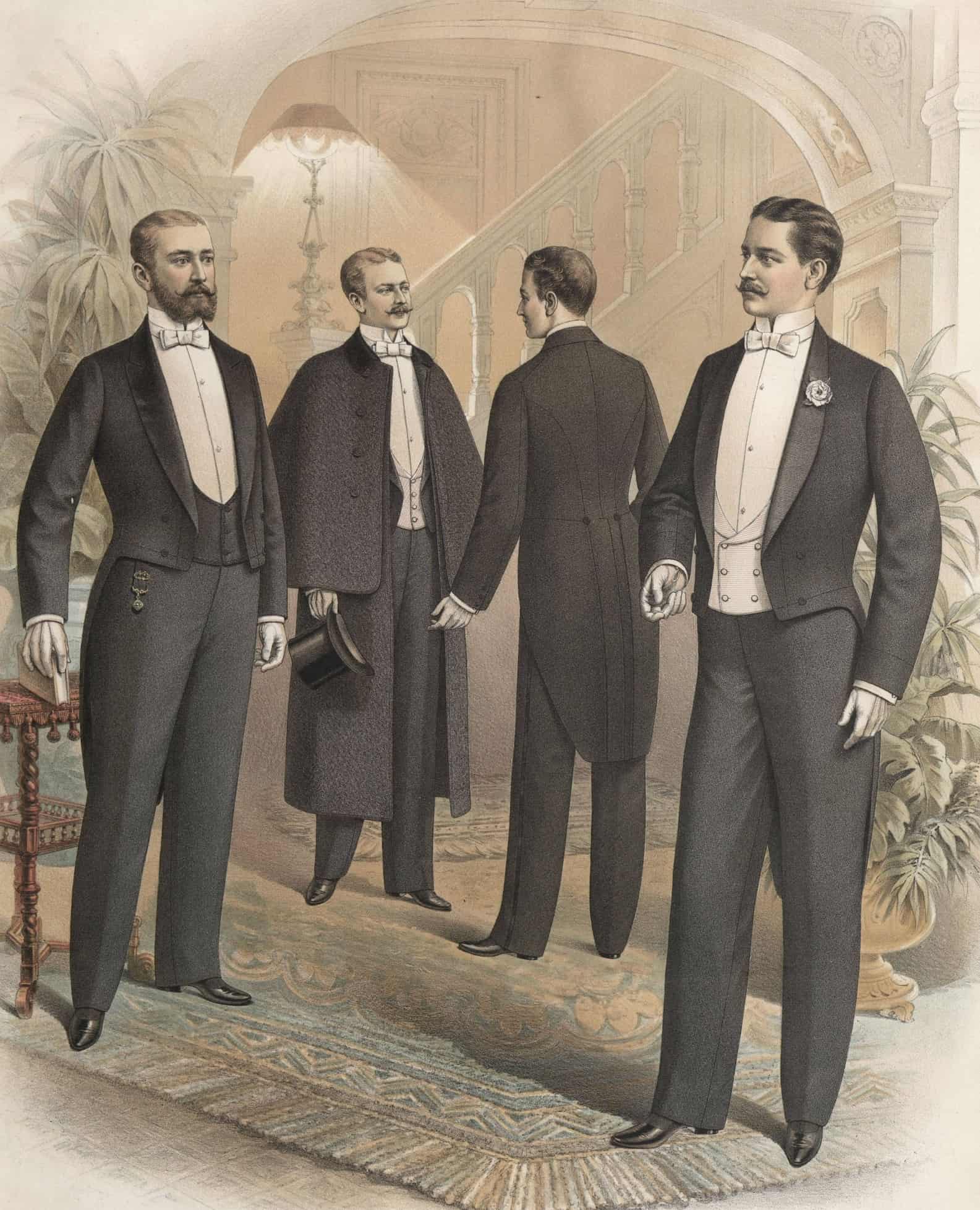 Eveningwear was very formal in the early 1900s
Eveningwear was very formal in the early 1900s
Around the turn of the century, black tie made its mark, and the tuxedo overtook the white tie dress code in popularity. Business suits became the standard daywear for decades.
It All Started With Aloha Fridays
Picture this: it’s 1966, and you work in an office wearing a suit and a tie. There is no debate about what is “office appropriate” when it comes to your clothes. You can wear your casual outfits at home on the weekends, but for the majority of your week, you’re in a suit.
Let’s face it, it’s the Mad Men era.
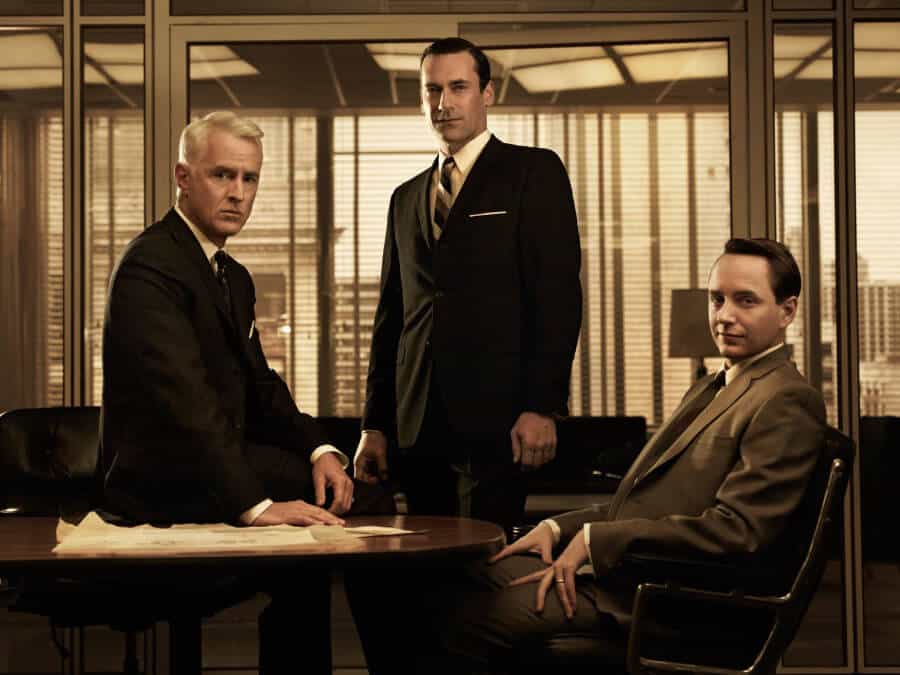 Don Draper’s conservative world was set to change as the business casual dress code started to take hold. [Image Credit: NorthJersey.com]
Don Draper’s conservative world was set to change as the business casual dress code started to take hold. [Image Credit: NorthJersey.com]
Then, a company making Hawaiian shirts recruits a brilliant ad agency that comes up with the idea of “Aloha Fridays.”
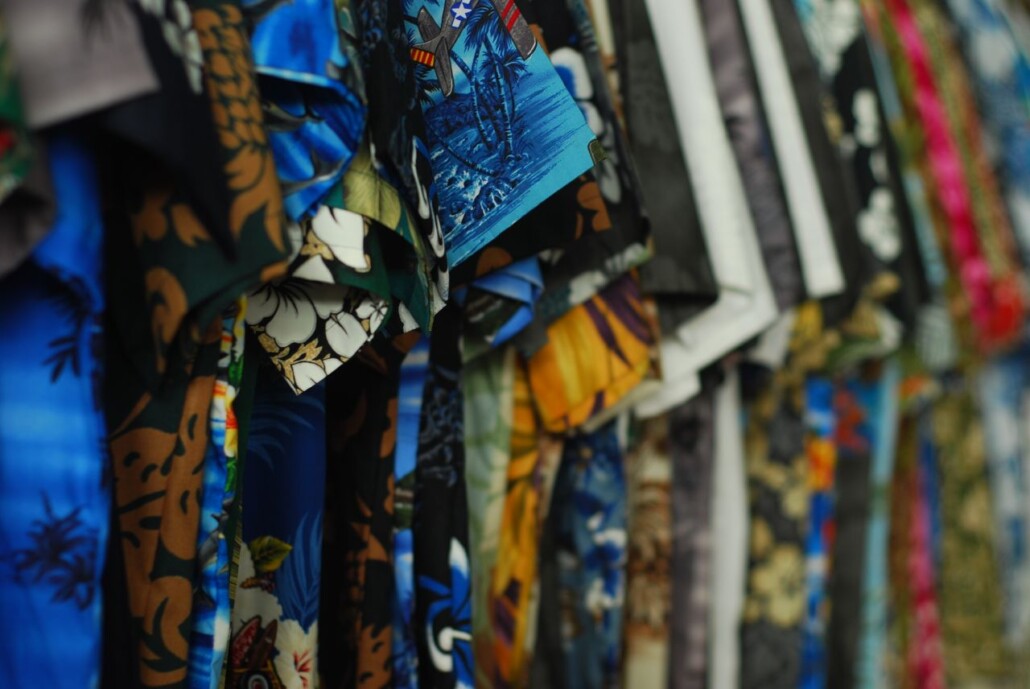 Hawaiian shirts are known the world over for being bright, colorful, and casual. Very much the opposite of traditional business clothing. [Image Credit: Wikimedia.com]
Hawaiian shirts are known the world over for being bright, colorful, and casual. Very much the opposite of traditional business clothing. [Image Credit: Wikimedia.com]
They begin petitioning local businesses to allow their employees to wear the Hawaiian shirt on Fridays. This trend quickly gathers steam as a popular way of avoiding the rat race of corporate America.
It’s the start of a revolution.
Dockers Ad Campaign Brings Khakis To The Office
Fast forward to the 1990s. Things have gone too far the other way, with shorts and t-shirts becoming the new office norm. World famous jeans brand, Levis, notice a chance to market their new brand, ‘Dockers’ to the corporate community. They launch expensive ad campaigns focusing on khaki pants, and it took off.
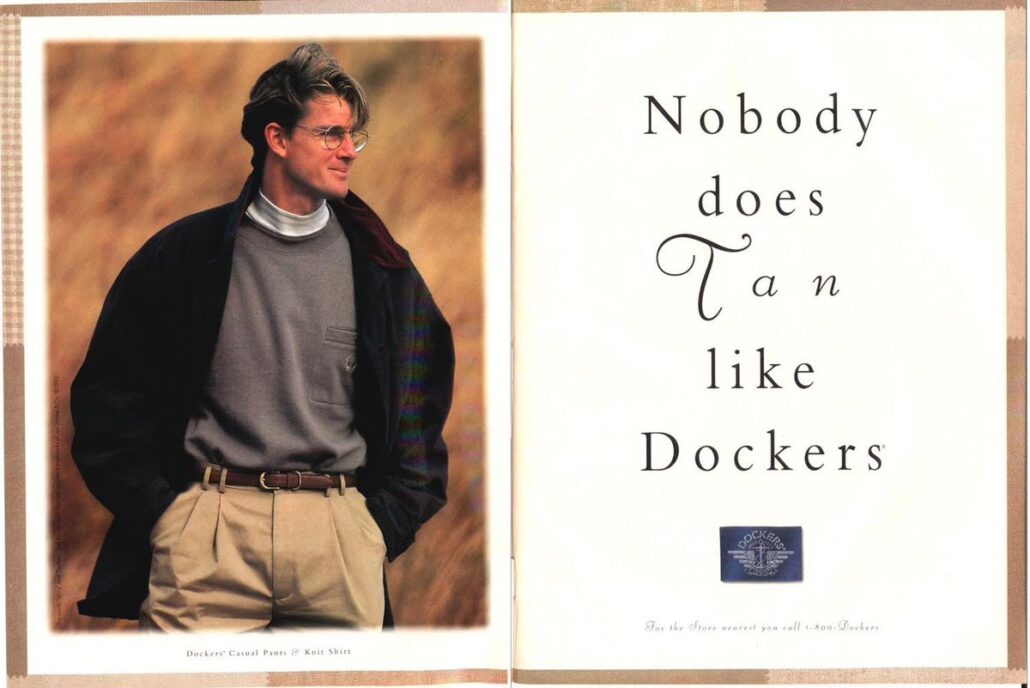 Docker’s started making business casual a more attainable dress code for men. [Image Credit: Twitter]
Docker’s started making business casual a more attainable dress code for men. [Image Credit: Twitter]
Employers see this as a fair middle ground between the too-casual shorts and the suits of a bygone era, and the employees agreed. Companies like Brooks Brothers, Ralph Lauren, and J.Crew are jumping on the opportunity to increase the sale of their preppy casual wear.
Business casual is born.
What’s The Issue With Business Casual?
Business Casual is an Undefined Term
For a lot of people, hearing “business casual” can be the same as the term “smart casual” it feels like an odd mix of two different dress codes, right? It can be easy to dress for business, and it can be easy to dress casually. But how do you mix both?
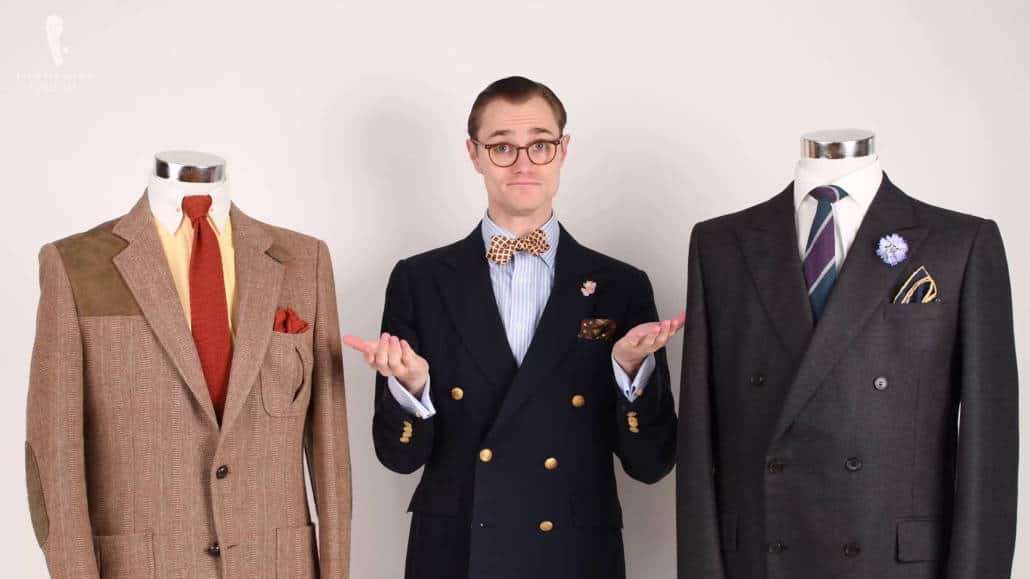 Is business casual formal or relaxed? This is the main issue for many who struggle with the dress code
Is business casual formal or relaxed? This is the main issue for many who struggle with the dress code
Different Workplaces = Different Tolerance Levels
One workplace might be fine with polo shirts and denim, but for another office, this will be too casual. Unfortunately, there’s no easy win here, as it will require you to get to know the lay of the land when it comes to your office space.
 Even at the Gentleman’s Gazette office, dress codes are flexible
Even at the Gentleman’s Gazette office, dress codes are flexible
Ultimately, the goal with the business casual dress code is to find outfits that fit within your company’s expectations, match your budget, and (most importantly) suit you.
Business Casual Defined
Simply put, to pull off business casual well, you need to steer clear of suits and shorts. Sounds easy, right? Suits or shorts represent two ends of the formality scale, suits being most formal and shorts being most casual.
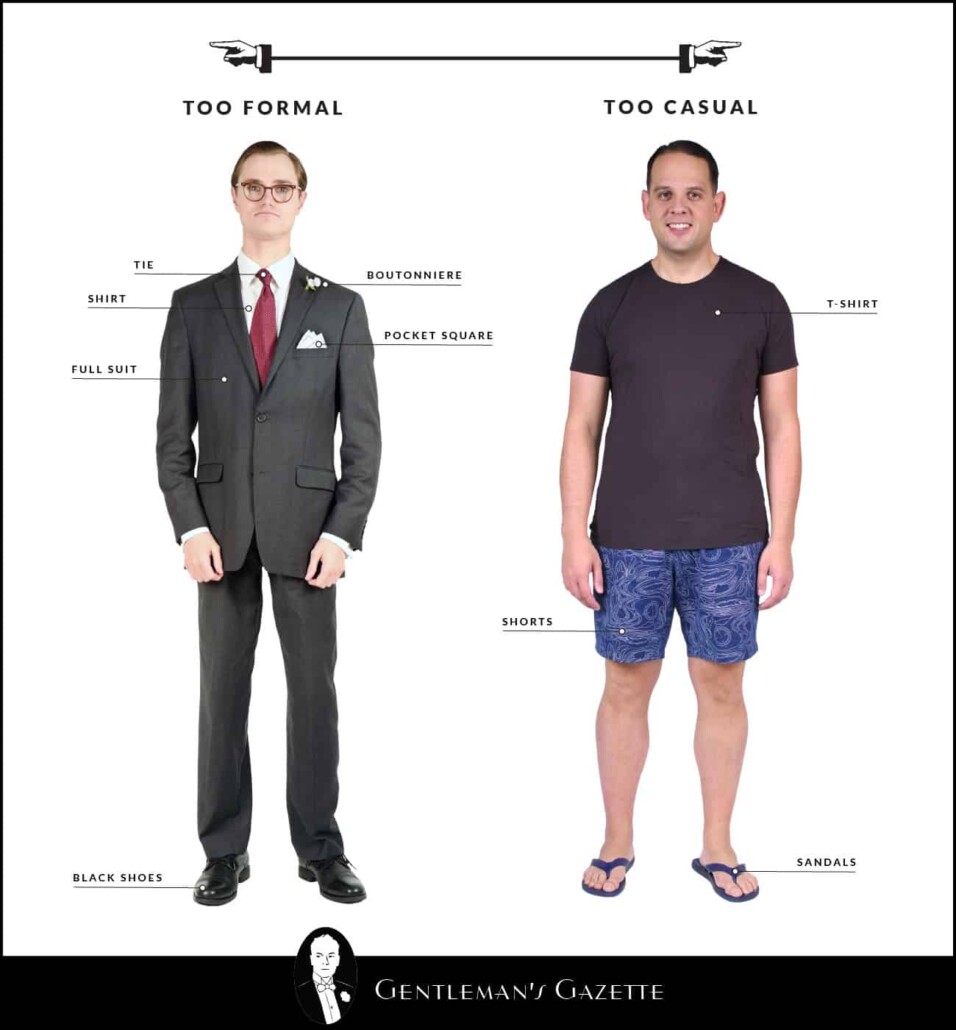 Here, you can see the extremes of being either too formal (Preston) or too casual (Raphael). Neither of these outfits are appropriate for the business casual dress code.
Here, you can see the extremes of being either too formal (Preston) or too casual (Raphael). Neither of these outfits are appropriate for the business casual dress code.
A great companion to this is our formality scale guide which you can find below. It goes deeper into the theories surrounding different formalities and will help you understand the decisions you’ll make about your business casual clothes.
So business casual is all about hitting that sweet spot in the middle. Not too dressed up, not too casual. Let’s start putting these theories into practice!
Know Your Working Environment
The first thing to establish is what type of office you have. You’re going to be the best judge of this by taking a look around at what your colleagues are wearing or just by asking them what they feel most comfortable wearing to work. It’ll make a welcome break in the watercooler conversation about what Netflix shows you’ve been watching!
As a general guide, here’s a range of some time and tested business casual outfits. You’ll see how the right combination of wardrobe pieces can lend a different look depending on what type of office you’re in.
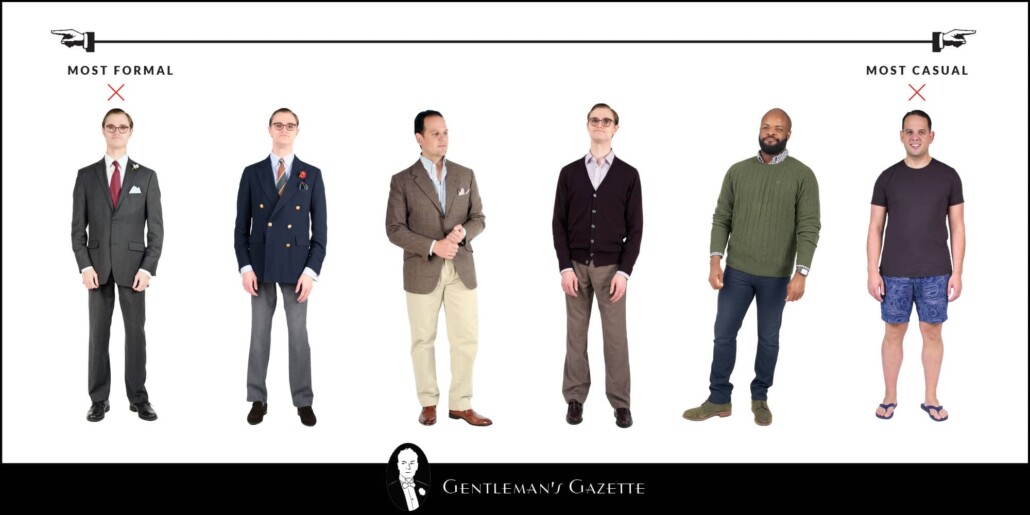 Adding some variety to the lineup, you can see how a business casual outfit can be made either smarter or more relaxed, depending on how you mix and match items.
Adding some variety to the lineup, you can see how a business casual outfit can be made either smarter or more relaxed, depending on how you mix and match items.
If you’re still not sure, we’ve put together a guide for you here to help identify where your office may sit in terms of formality. We’ve used the traditional “collar” rating system, which typically assigns the color of the collar based on how much manual labor is involved in your daily activities. However, in the 21st Century, there’s no one set way of working, and you could be expected to have greater flexibility in your role.
Which “Collar” Are You?What Does Your Workday Look Like?What Level Should You Look at?White CollarYou spend the majority of your day in a traditional office environment with little to no manual labor as part of your duties. You need to look respectable and present a professional image.Formal to Everyday Business CasualGrey CollarYou do a healthy mix of both labor-intensive and office-based tasks. You need to look presentable but also practical.Everyday Business CasualBlue CollarTraditionally labor-intensive or service-based roles. Your work clothes may have been provided, but you still want to look good for interviews, meetings, and other times when you’re at work without a uniform.Casual to Everyday Business Casual
Business Casual Essentials
Business Casual Jackets
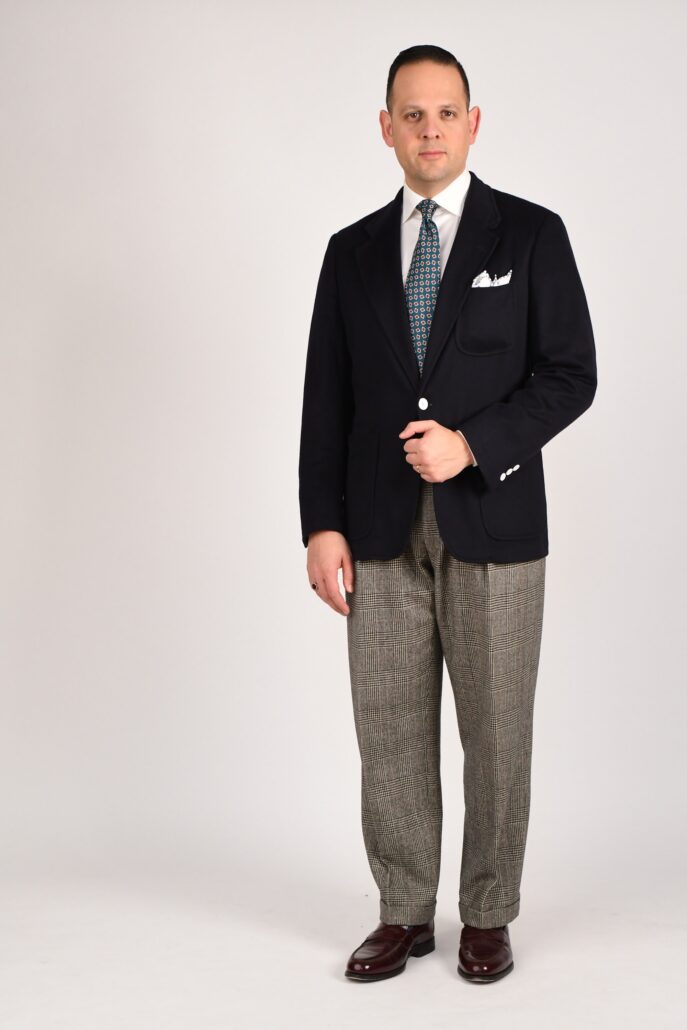 Navy blazer – more formal
Navy blazer – more formal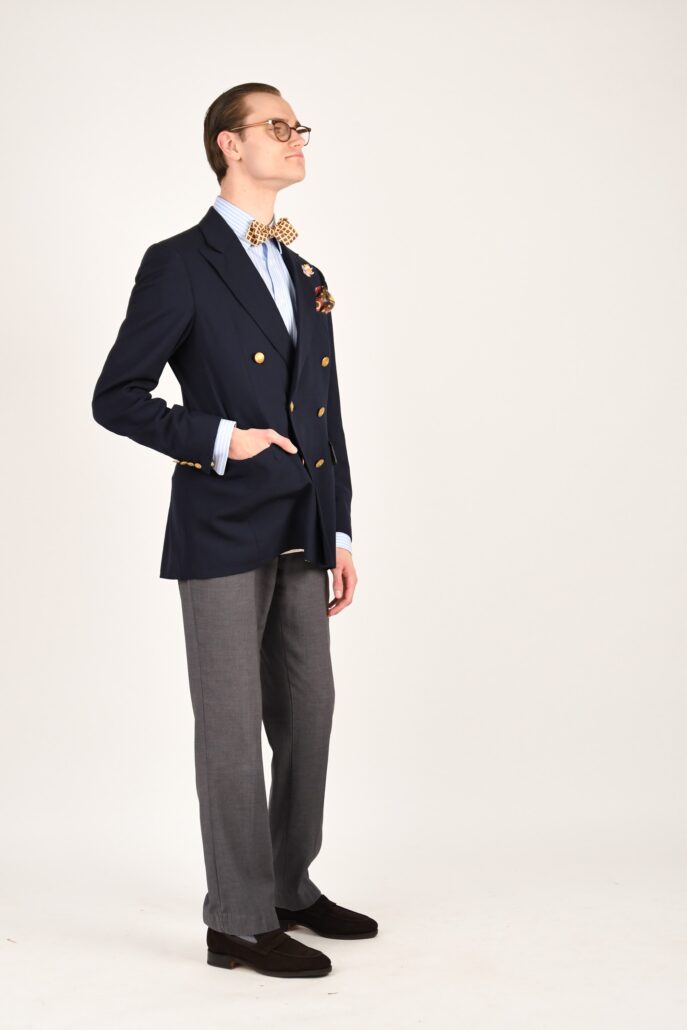 Navy blazer – more formal
Navy blazer – more formal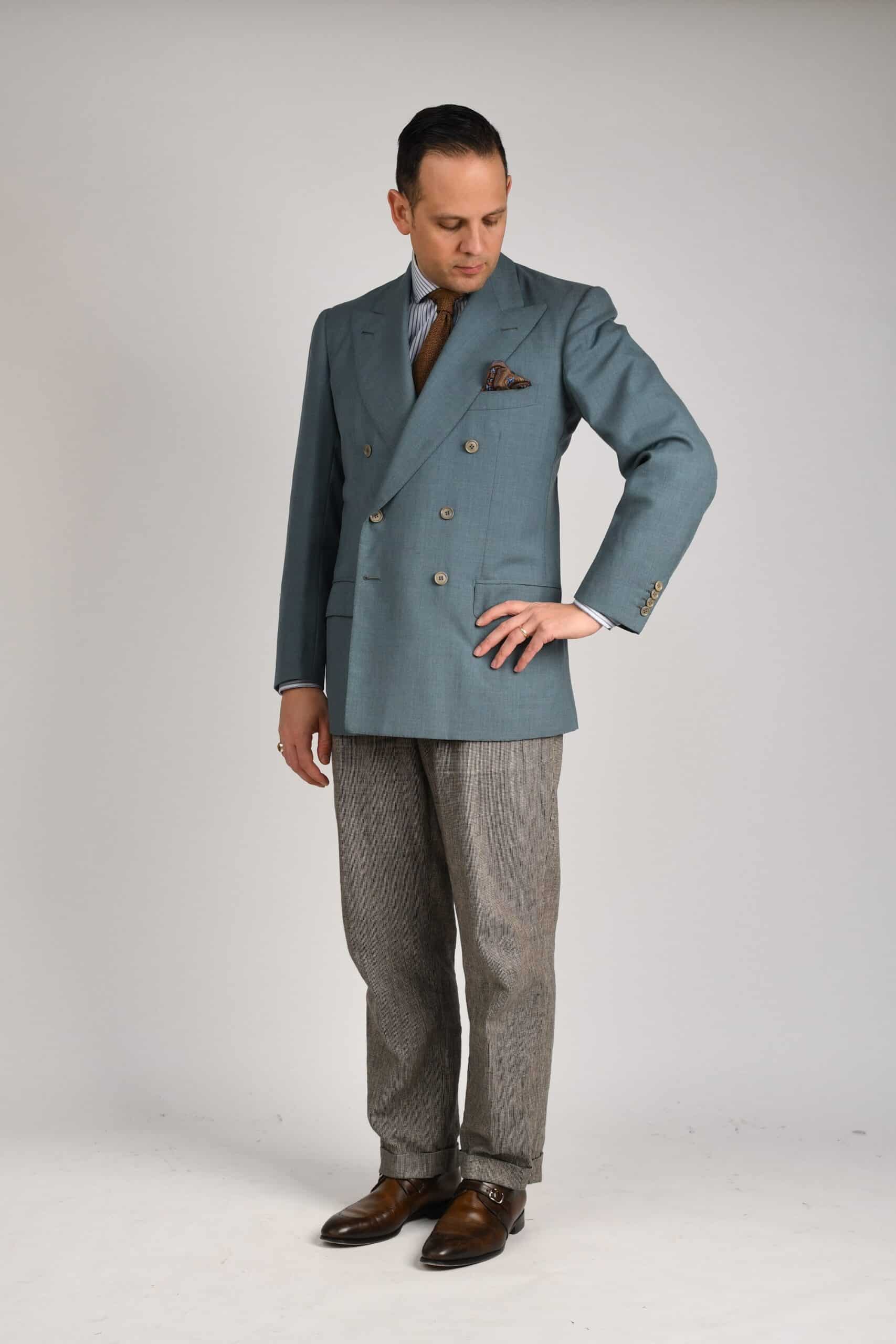 Odd jacket – less formal
Odd jacket – less formal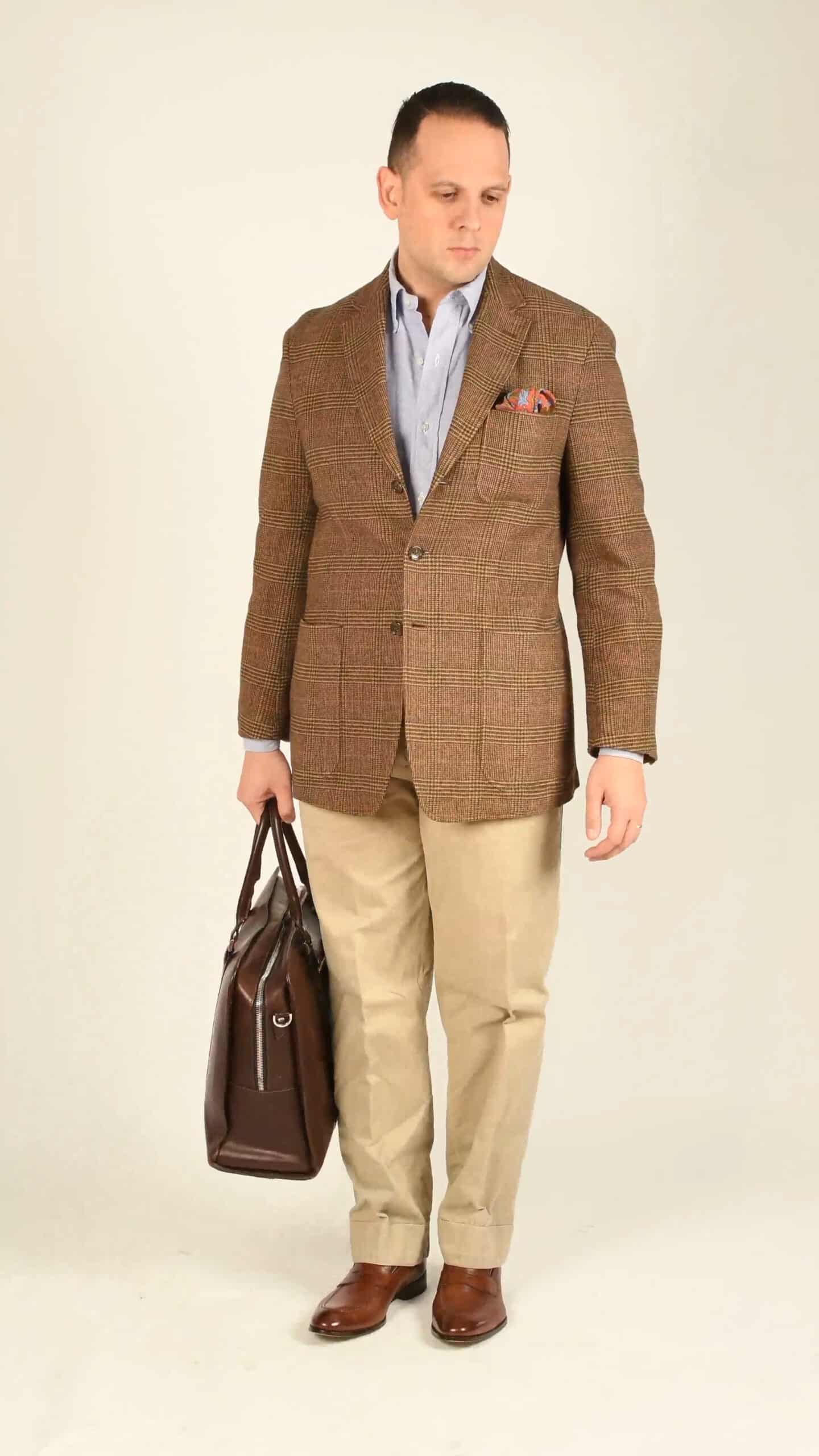 Odd jacket – less formal
Odd jacket – less formal
Navy Blazer – More Formal
The undisputed king of business casual jackets, the navy blazer is a must-have for your business casual wardrobe. Simple to combine with a wide range of shirts, pants, and accessories, you’ll be hard-pressed to find another garment that fits the business casual dress code as well as this.
Odd Jacket – Less Formal
If a navy blazer strikes things a little too formal for your tastes, but you still want to wear a tailored top layer, then an odd jacket is the garment for you. Indulge in seasonal fabrics by having a couple of odd jackets in your business casual wardrobe, and enjoy relaxed detailing such as softer construction and patch pockets to ensure your colleagues know you mean business when it comes to dressing well.
The best RTW blazer under $500?
Find out here!
Business Casual Knitwear
 Dark cardigan – everyday/casual
Dark cardigan – everyday/casual Cardigans and sweaters can become formal with the right accessories
Cardigans and sweaters can become formal with the right accessories Navy sweater – everyday
Navy sweater – everyday
Fine Sweater – More formal
A fine sweater in merino or cashmere fibers is an elegant way to incorporate an additional layer into your business casual ensemble. If you feel the warmth, why not try the look without a jacket, and let the knitwear shine? Providing you choose timeless menswear colors such as navy, grey, dark greens, and browns, your sweater choices will be spot on.
Cardigan – Less formal
As an alternative to a sweater, opt for a cardigan. A shawl collar can tone down the formality a little, which can be great on a dress-down Friday in a business casual workplace.

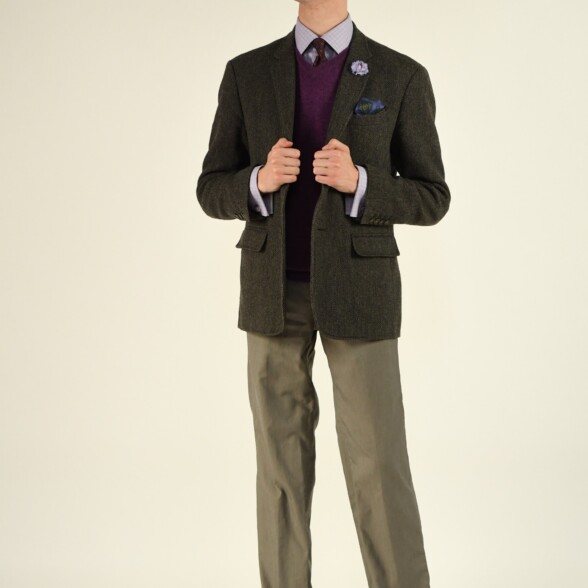
Layering up
Sweaters can be worn on their own or are great as a layering piece for your business casual wardrobe.
Business Casual Shirts
 Pastel dress shirt – More formal
Pastel dress shirt – More formal Dark dress shirt – mid-formal
Dark dress shirt – mid-formal OCBD shirt – less formal
OCBD shirt – less formal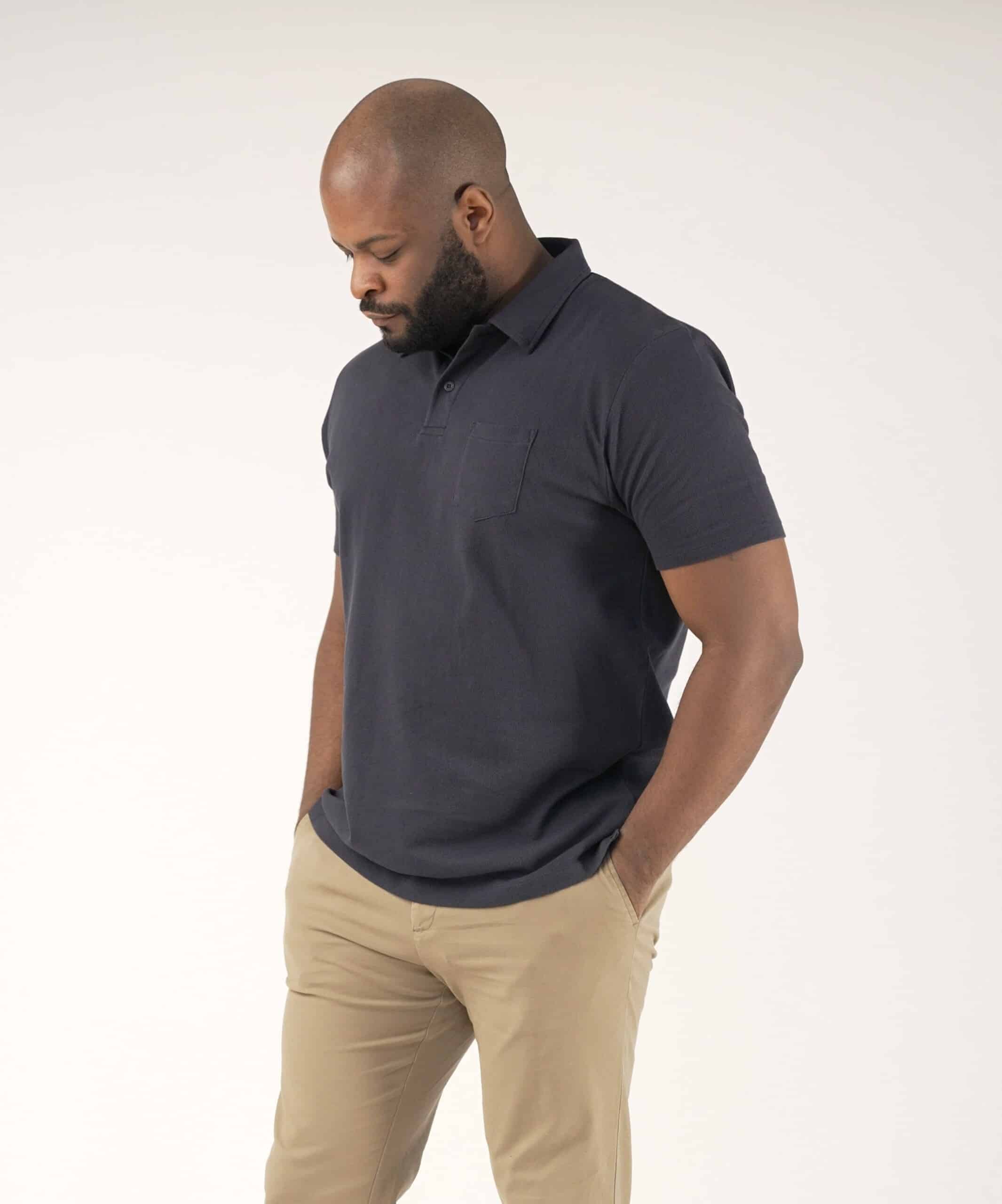 Polo shirt – casual
Polo shirt – casual
Dress Shirts – Formal
A staple of any classic clothing enthusiast’s wardrobe is the dress shirt, and it’s absolutely at home within the realms of business casual, too. White will always be appropriate, but why not take this opportunity to explore unique textures, patterns, and tasteful colors for your dress shirts – pinks, blues, and pastel tones are a way to liven up your business casual dress shirts.

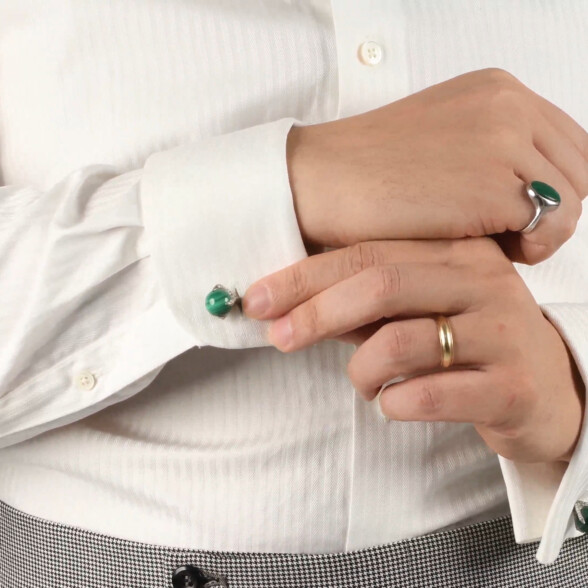
Avoid Cufflinks
Unless you’re going out for a more formal event after the workday, we’d suggest sticking clear of cufflinks. French, or double-cuff shirts are a step too formal for your business casual wardrobe. Go for barrel, or button cuffs instead.
Oxford Cloth Button Down Shirts (OCBD) – Everyday
A stalwart of menswear, the Oxford Cloth Button Down (OCBD) shirt is the perfect accompaniment to a business casual look. Existing within the realms of neither too dressed-up nor too relaxed, this model of shirt is well at home within this dress code.
Polo Shirts – Casual
For workplaces that are on the casual end of business casual, go for polo shirts. Whether it’s the traditional short sleeve version or the marginally dressier long sleeve option, a polo shirt works better than a T-shirt because it possesses a collar, instantly making you look more respectable.
Business Casual Pants
 Tailored pants – formal
Tailored pants – formal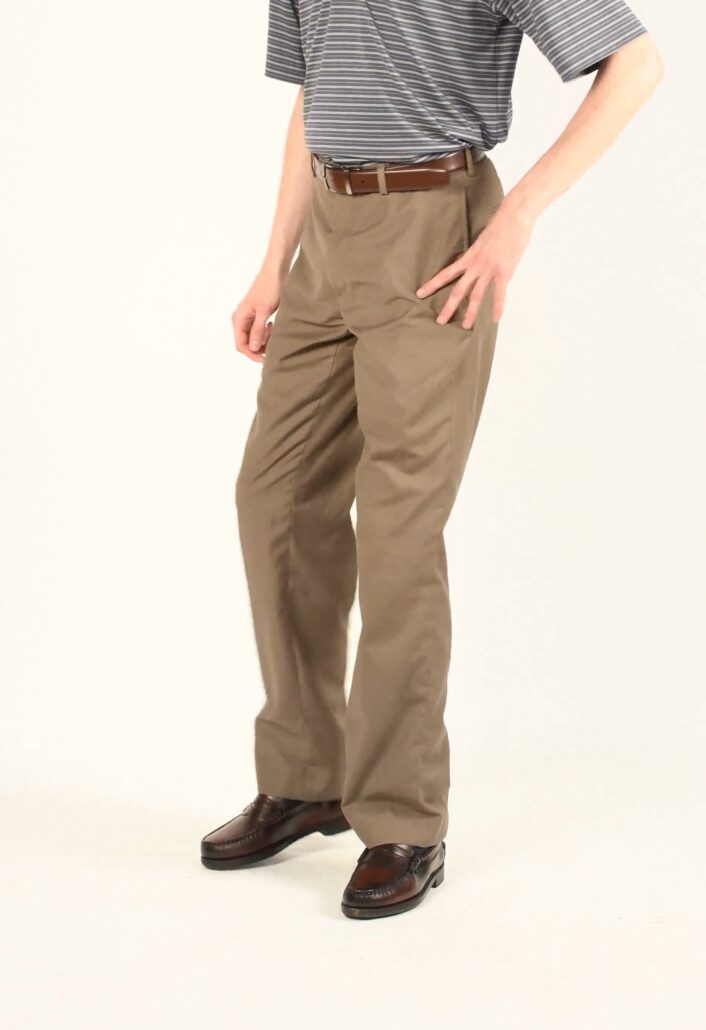 Khakis – everyday
Khakis – everyday Corduroys – casual
Corduroys – casual
Tailored Pants – Formal
Every gentleman should own a pair of well-made, tailored pants. That doesn’t mean they have to be bespoke, just that they’re constructed with some formality, fit for pairing with a jacket on those dressier days. Fabric options such as flannel and fresco will have you covered for both cold and warm temperatures, respectively, so you can work (and look) cool.
Khakis/Chinos – Everyday
Just as the OCBD is the essential business casual shirt, the same is true for business casual pants and khakis. A sturdy cotton trouser in the classic buff color will always be business casual appropriate, but why not experiment with a pair in navy or deep green? You’ll be surprised by how versatile they can be.
Corduroy Pants- Casual
Remarkably comfortable and therefore excellent for the most relaxed business casual offices, corduroys are a safe addition to your wardrobe. Think of them as a sartorial cousin of jeans, and you’ll be pairing them with your other business casual pieces in no time!
Business Casual Shoes
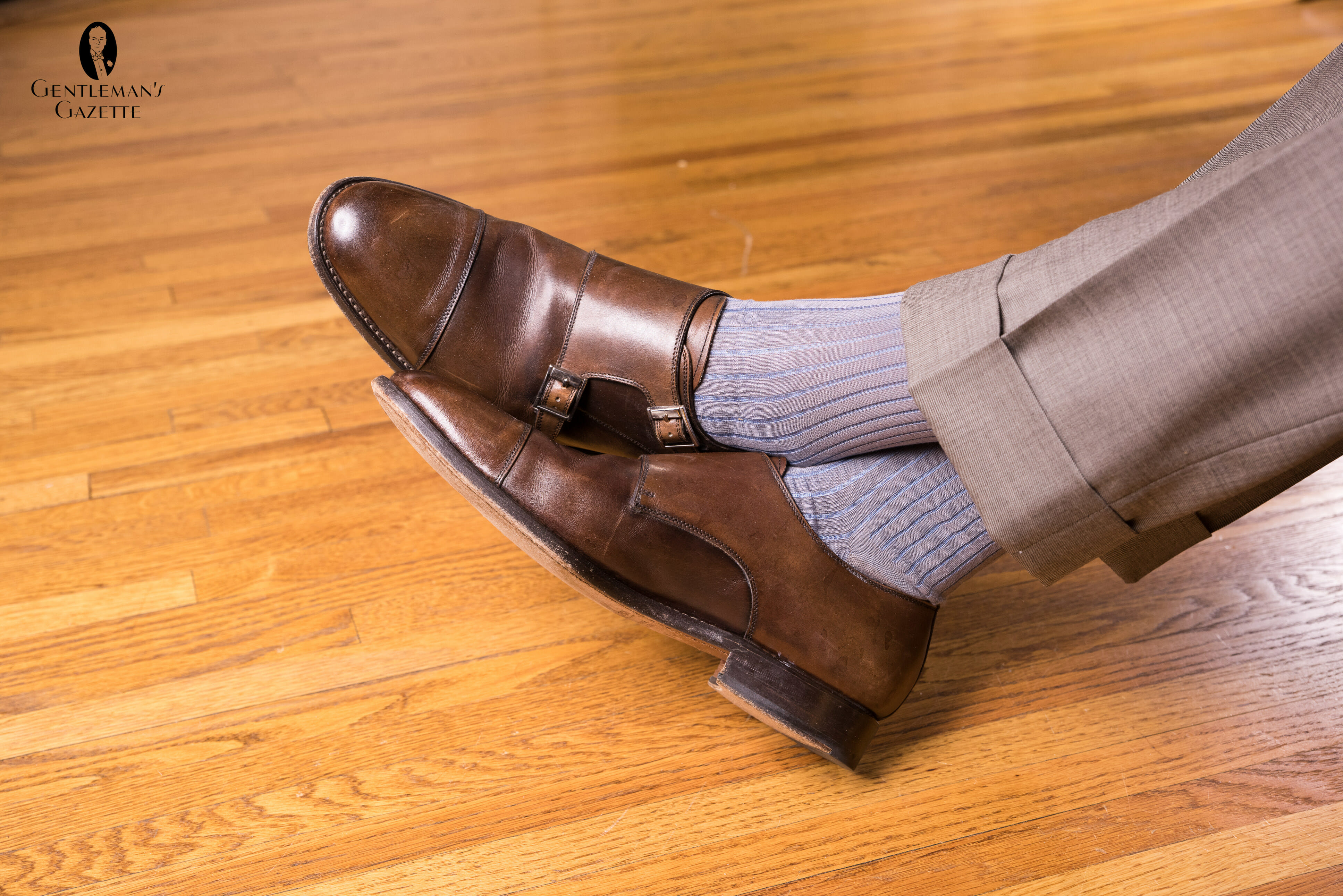 Monkstraps – formal
Monkstraps – formal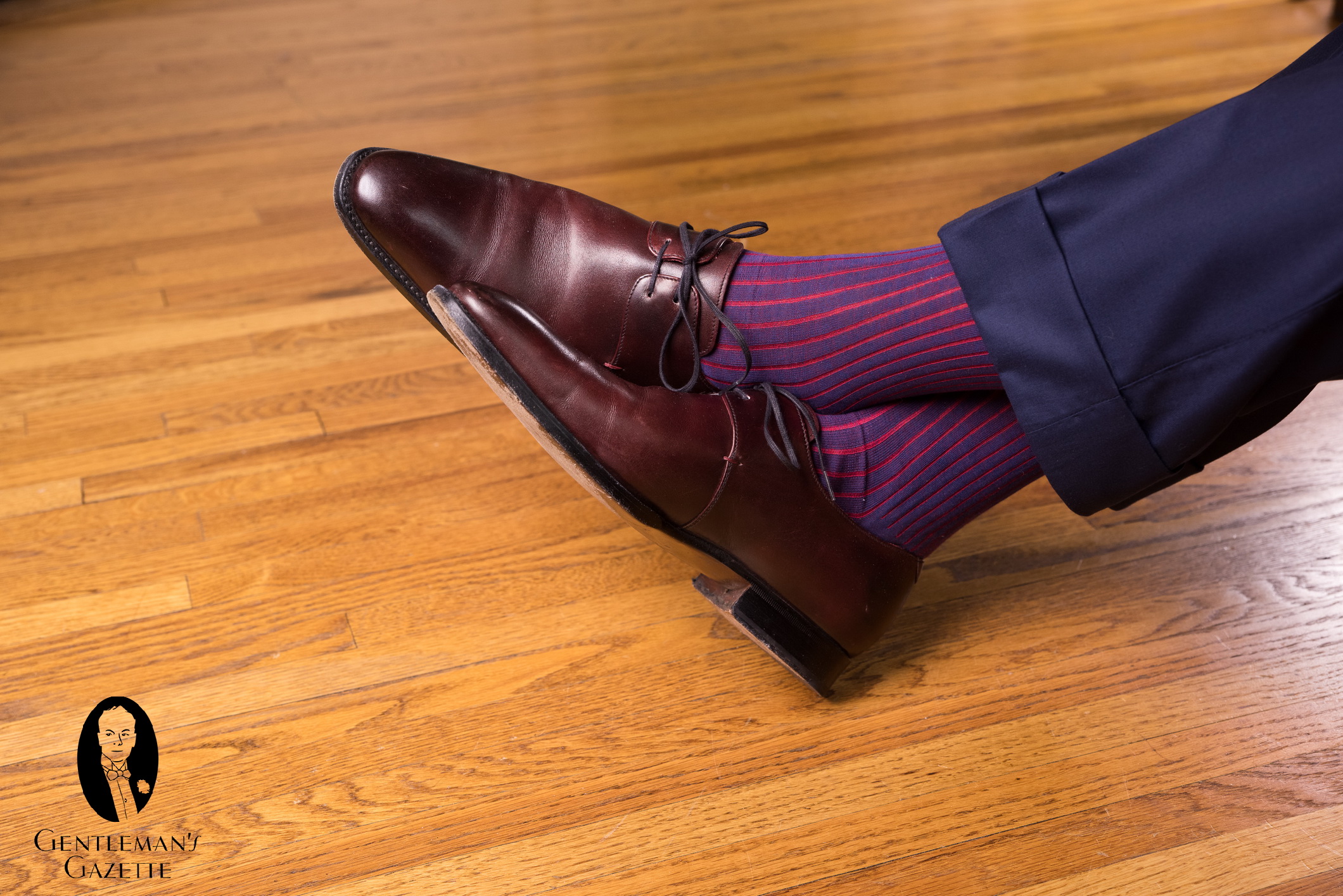 Derbies – formal
Derbies – formal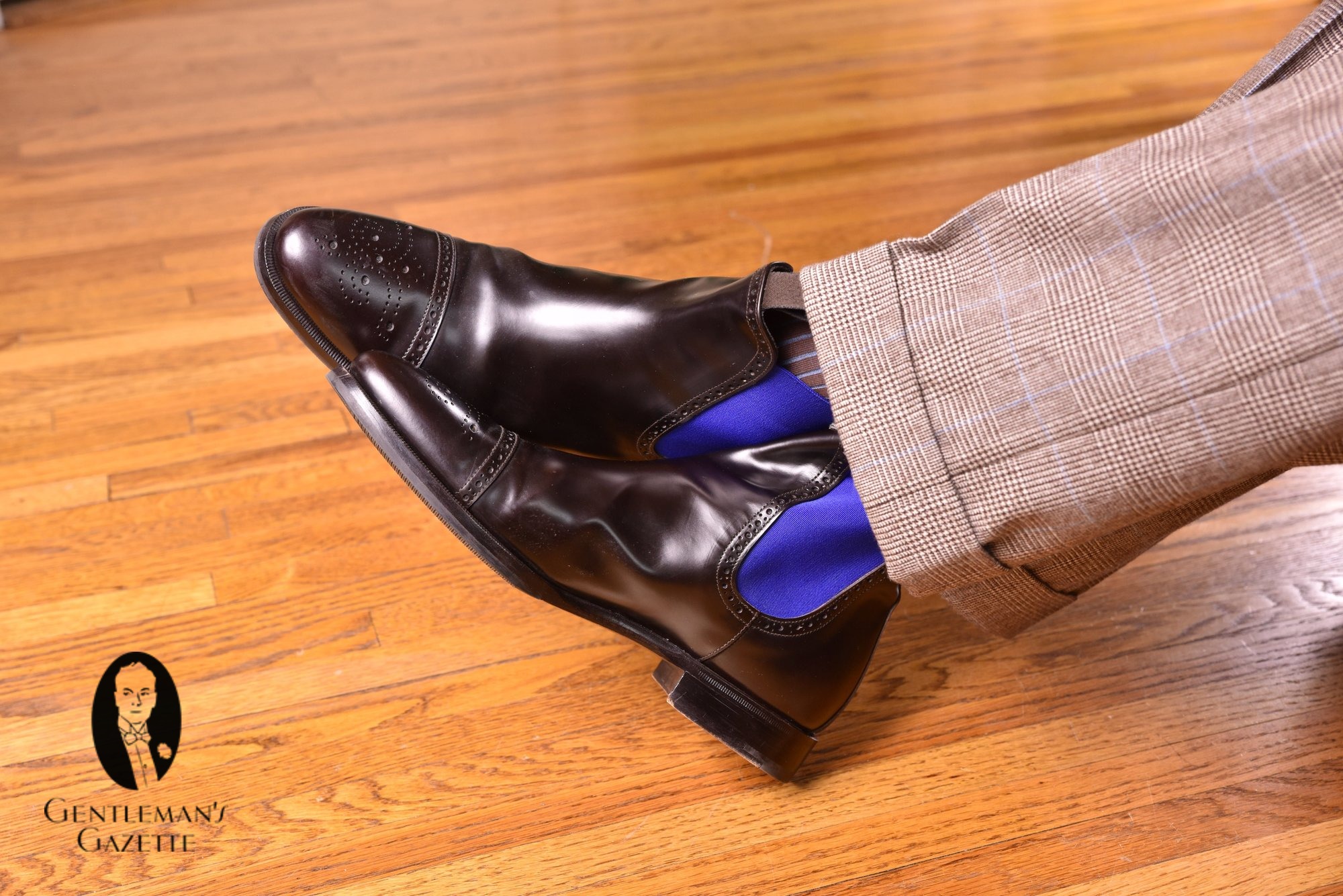 Chelsea boots – everyday
Chelsea boots – everyday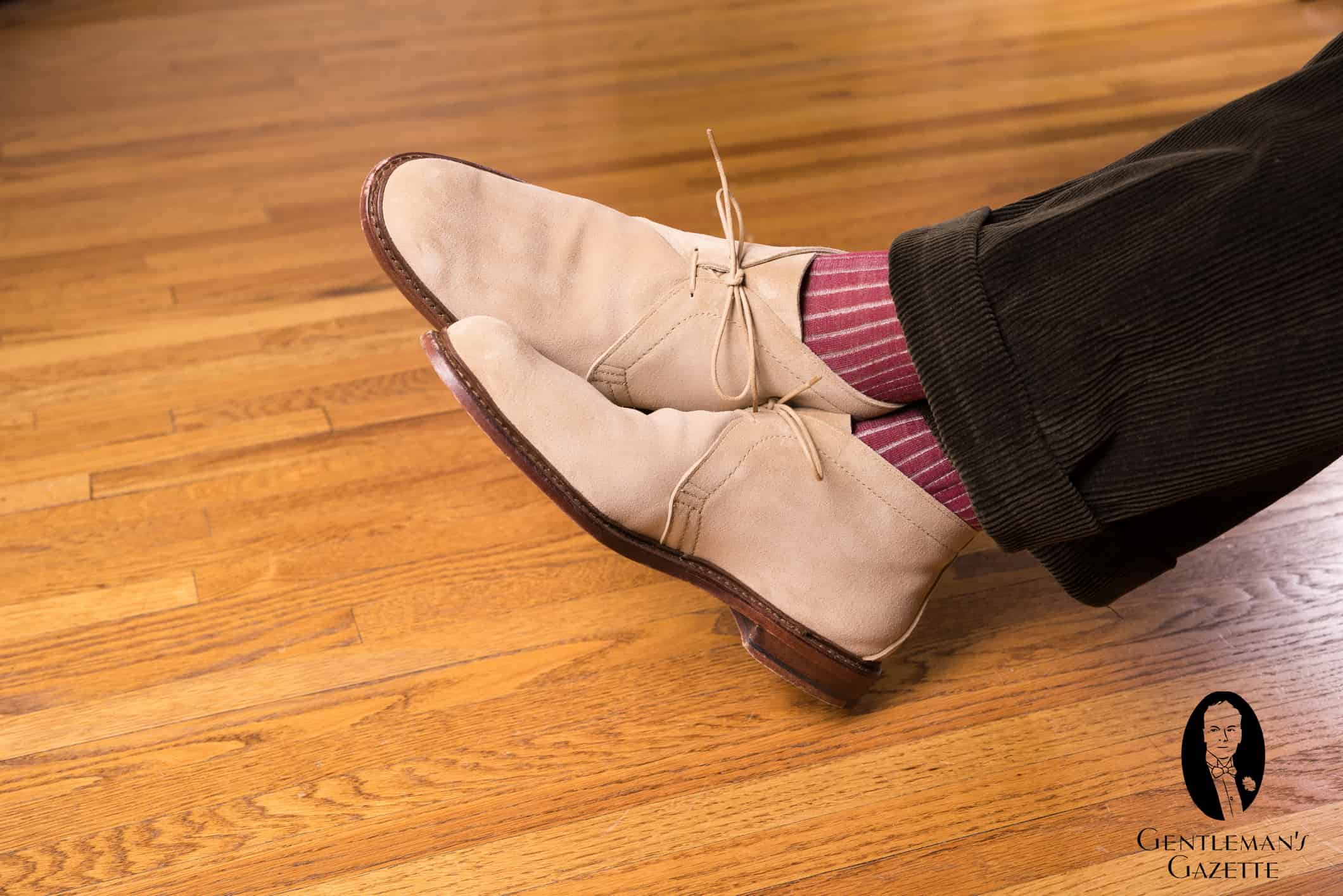 Chukka boots – everyday/casual
Chukka boots – everyday/casual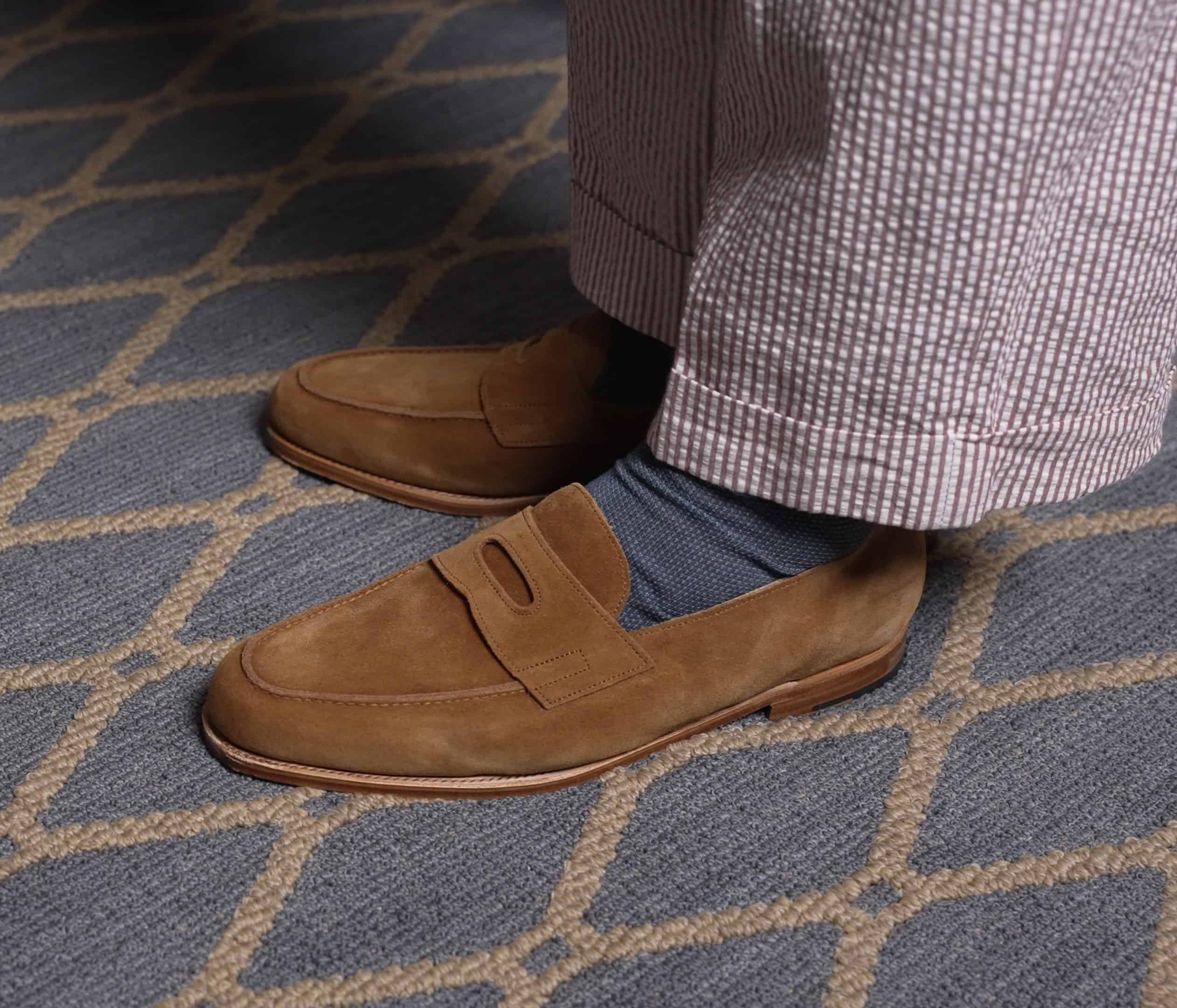 Loafers – casual
Loafers – casual
Monkstraps – Formal
Skip the formal Oxfords and go instead for a pair of monkstrap shoes for your formal business casual option. Remember, you can reduce the formality with additional details such as broguing, wing tips, or a cap toe.
Derbies – Formal/Everyday
If laced shoes are your thing, then a pair of Derbies is the way to go. Colors such as oxblood will strike a higher level of formality, while you’ll be able to tone things down with lighter shades of browns.
Chelsea Boots – Everyday
A classic style staple, Chelsea boots are a great everyday addition to your business casual collection. They strike a balance of being neither too formal nor casual, and the material choice certainly helps, too. Go for suede if you want to relax things, or a polished leather if you prefer a smarter edge.
Chukka Boots – Everyday/Casual
Whether it’s a pair of desert boots or a pair that’s been well lasted, chukka boots are a fantastic way to incorporate a bit of style into your business casual wardrobe.
Loafers – Casual
Always a favorite for their style and simplicity, go for a pair of soft loafers any time you want to dress your business casual outfit down.
Business Casual Outerwear

 Trench coat – formal
Trench coat – formal Pea coat – everyday
Pea coat – everyday Harrington jacket – casual
Harrington jacket – casual
Trench Coat – Formal/Everyday
A trench coat is a time-and-tested classic item of outerwear and is welcome in the business casual dress code. Opt for a longer model for a more vintage, classic feel, or a shorter version if you prefer a modern aesthetic.
Pea Coat – Everyday
For those chilly days to and from the office, you really can’t beat a pea coat. Much less formal than a longer overcoat may be, you still feel the benefit of an overlapping double-breasted closure, at the same time enjoying the smartness that classic navy brings to an outfit.
Harrington – Everyday/Casual
If you want to retain a smart edge without feeling overly dressed up, a Harrington jacket is a great piece to incorporate into your business casual wardrobe. Go for simple lines in a classic color, and whether it’s dress-down Friday or just a regular day at the office, you’ll be looking just right.
Business Casual Accessories
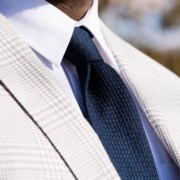
Always useful
Add a Classic Tie
A navy grenadine tie is a must for any business casual wardrobe. Timeless, elegant, and will be ready when you need it to compliment a wide range of outfits.
Add a Navy Grenadine Tie to your collection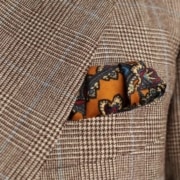
For a touch of color
Pocket Squares
Invest in a pocket square or two to elevate your business casual outfit. Tasteful patterns and classic colors will make pocket squares a neat addition to your breast pocket
Pick a Pocket Square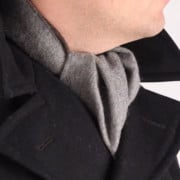
For chilly office days
A Two Tone Scarf
You can’t control the weather, and you probably can’t control your office temperature either! A scarf if a wise choice to have handy in case of a sudden change in the temperature – in or out of the office!
Keep a Scarf handy
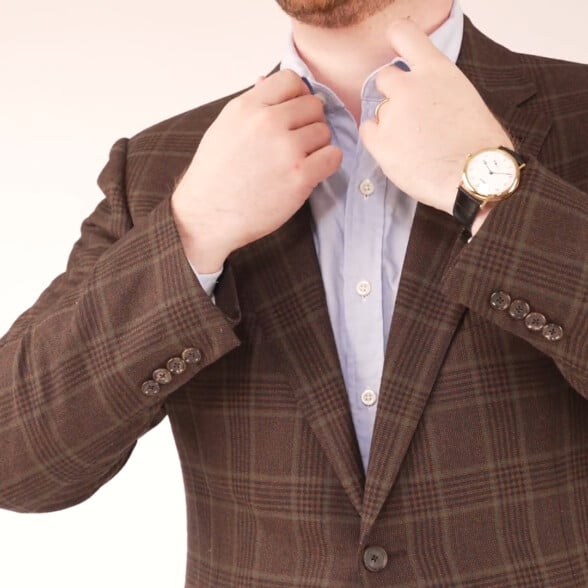
An Understated Watch
Don’t forget to add a timepiece to your business casual ensemble if you enjoy wearing one. Steer clear of super casual watches such as digital models, smartwatches, and dive pieces. Instead, choose something simple and elegant, such as a dress watch or a refined chronograph.

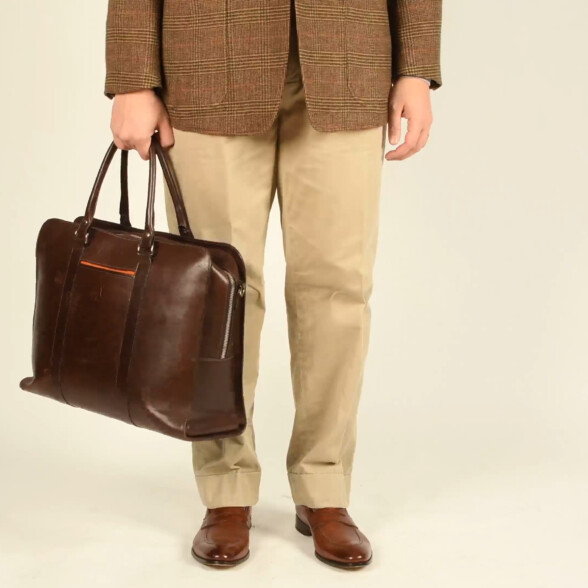
Carry a Bag
A timeless leather bag should be your business casual go-to for carrying all your work needs. A modern, soft leather briefcase or tote bag will be a great choice for any business casual wardrobe.
Business Casual Tips
Business Casual Tips
1
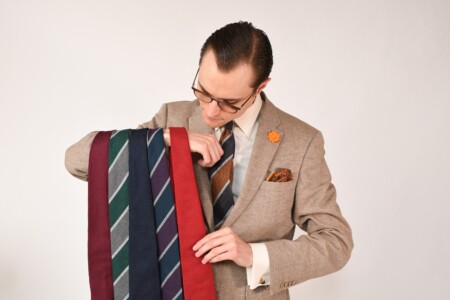
Keep a tie handy at all times
A simple, classic tie such as a model in navy grenadine will save you more than you expect. Boss come in without warning? Meeting a client unexpectedly? Having that tie in your bag or in your desk will be a lifesaver. Just remember to put it back for next time!
2
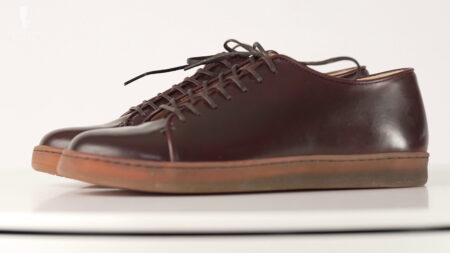
Sneakers should be simple
If your company allows them, sneakers should be plain, elegant and tasteful dress sneakers. If you’re on the fence, leave them at home!
3
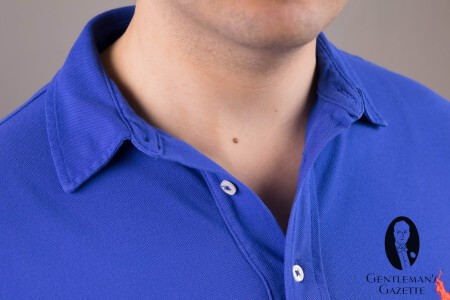
Collars, please!
The shirt you wear for a business casual outfit needs to have a collar, so this means no t-shirts, and no visible undershirts. A collar instantly smartens you whole look, as it works to frame your face in the most flattering way.
4
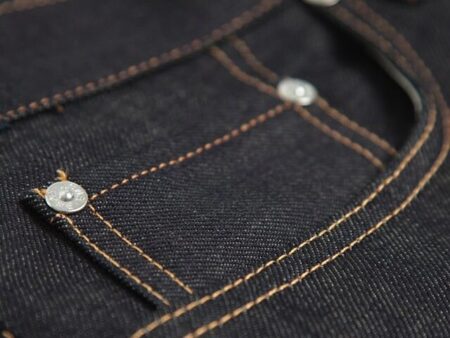
Dark denim only
While many offices won’t accept jeans as part of their business casual dress code, a few will allow them. If your office does, then keep to elegant, dark denim instead of anything with fades, rips or embellishments.
5
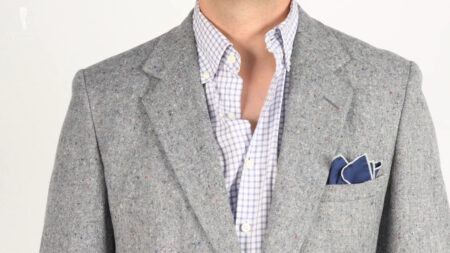
Simplicity is key
A business casual outfit should be about making your work day easy, comfortable, and professional. It can be tempting to dive into different combinations of colors and textures within the somewhat undefined barriers of the dress code, but your outfit (and job role) will benefit from maintaining a sartorial simplicity.
Putting It All Together
Now that we’ve laid out all the hallmarks of business casual dressing, let’s put all the pieces together; the video below shows off five example outfits from which you can draw even more inspiration.
Business Casual FAQs
Do you tuck in your shirt for business casual?
In a word, yes! Tucking in your shirt will give a neater, cleaner appearance – the cornerstones of a professional image.
What is business casual for a job interview?
Take some time to research the company you’re going to interview for, chances are you’ll get a good impression of how formally they take business casual with a little preparation. If in doubt, a jacket and tie will always be welcome in your sartorial arsenal!
Are skinny pants business casual?
Regardless of how smart the fabric of your pants is, they won’t cut the mustard if they’re hugging you like a pair of leggings. Skinny clothing is inherently casual, so it’s best to save the spray-on look for the weekend!
Are black jeans appropriate for business casual?
Any form of denim is going to be up to your workplace’s rules about what is and isn’t appropriate for business casual, and a pair of black jeans will fall under these rules too. Assume they’re not going to be appropriate at first, and ask your colleagues if they’d be happy with you wearing a pair if they’re something you really want to wear. Just don’t be shocked if the answer is “no”!
Can you wear sneakers for business casual?
Much like denim, sneakers are typically going to be seen as inappropriate for business casual. There may be an exception for a pair of smart dress sneakers, but it’s always best to check it out with the rest of the office before assuming sneakers are okay.
Is a suit acceptable for business casual?
Not something we often say at the Gentleman’s Gazette, but you want to avoid wearing a suit for the business casual dress code. As it is a complete and formal image, it is all business and not casual enough for this dress code.
Can shorts be business casual?
If shorts were always at a modest length, they might be appropriate for business casual – as it happens, there’s too much variety in what is and isn’t an appropriate length of shorts. Therefore, stick to full-length pants for business casual.
Do you need a tie for business casual?
A tie can be a great addition to your business casual wardrobe. Even if you don’t wear one too often, keep one classic tie handy – know when you’ll want to smarten up!
Is a vest/waistcoat business casual?
An odd vest or waistcoat could well be considered appropriate for a business casual outfit. The key to making it work is to balance the formality of the other elements of your outfit. For example, don’t wear a waistcoat, jacket, and tie – choose to remove one of these items, and you’ll have a more coherent business casual outfit
What if your office has dress-down Fridays?
Dress-down Fridays can be a nice opportunity to relax your dress code to the next formality down from how you usually dress within the realms of business casual. This may mean shorts, denim, and sneakers are allowed on Fridays in your office, but we’d suggest sticking to the most relaxed end of the business casual dress code for an elevated dress-down Friday.















![Toni Kroos là ai? [ sự thật về tiểu sử đầy đủ Toni Kroos ]](https://evbn.org/wp-content/uploads/New-Project-6635-1671934592.jpg)


